change wheel Oldsmobile Cutlass 1998 Owner's Manuals
[x] Cancel search | Manufacturer: OLDSMOBILE, Model Year: 1998, Model line: Cutlass, Model: Oldsmobile Cutlass 1998Pages: 348, PDF Size: 17.46 MB
Page 97 of 348

Cruise Control
With cruise control, you can maintain a speed of about
25 mph (40 lun/h) or more without keeping your
foot
on the accelerator. This can really help on long
trips. Cruise control does not work at speeds below
25 mph (40 km/h).
When you apply your brake, the cruise control shuts off.
e
e
Cruise control can be dangerous where you
can’t drive safely at a steady speed.
So,
don’t use your cruise control on winding
roads or in heavy traffk.
Cruise control can be dangerous
on
slippery roads. On such. roads, fast changes
in tire traction can cause needless wheel
spinning, and you could lose control. Don’t
use cruise control on slippery roads.
2-33
Page 154 of 348
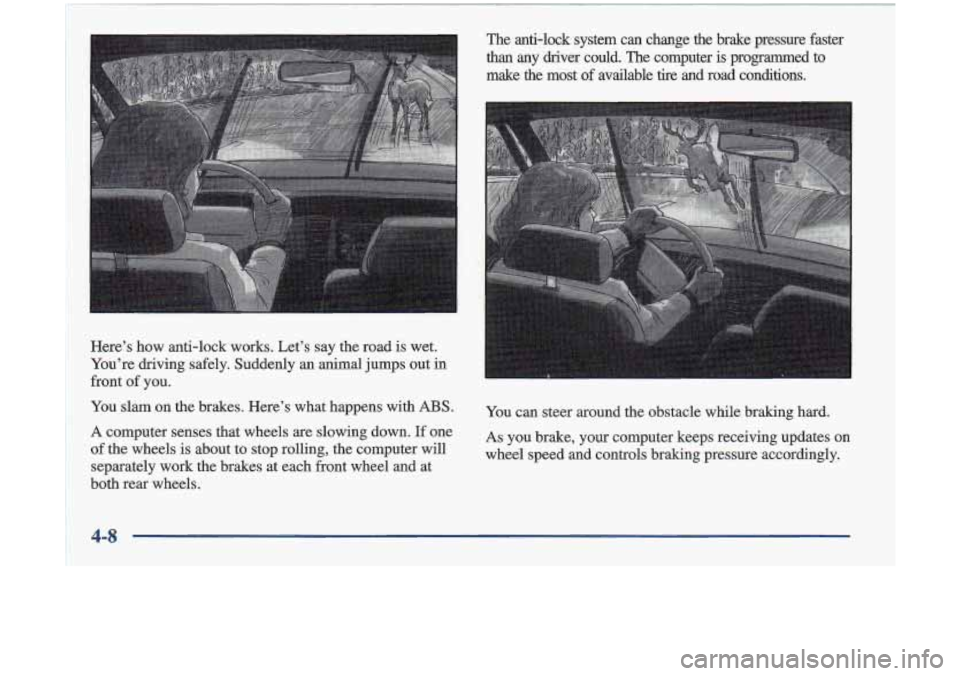
Here’s how anti-lock works. Let’s say the road is wet.
You’re driving safely. Suddenly an animal jumps out
in
front of you.
You slam on the brakes. Here’s what happens with
ABS.
A computer senses that wheels are slowing down. If one
of the wheels is about to stop rolling, the computer will
separately work the brakes at each front wheel and at
both rear wheels. ‘Me
anb-lock system
can change the brake pressure faster
than any
driver could. The computer is programmed to
make the most of available tire and road conditions.
You can steer around the obstacle while braking hard.
As you brake, your computer keeps receiving updates on
wheel speed and controls braking pressure accordingly.
4-8
Page 155 of 348
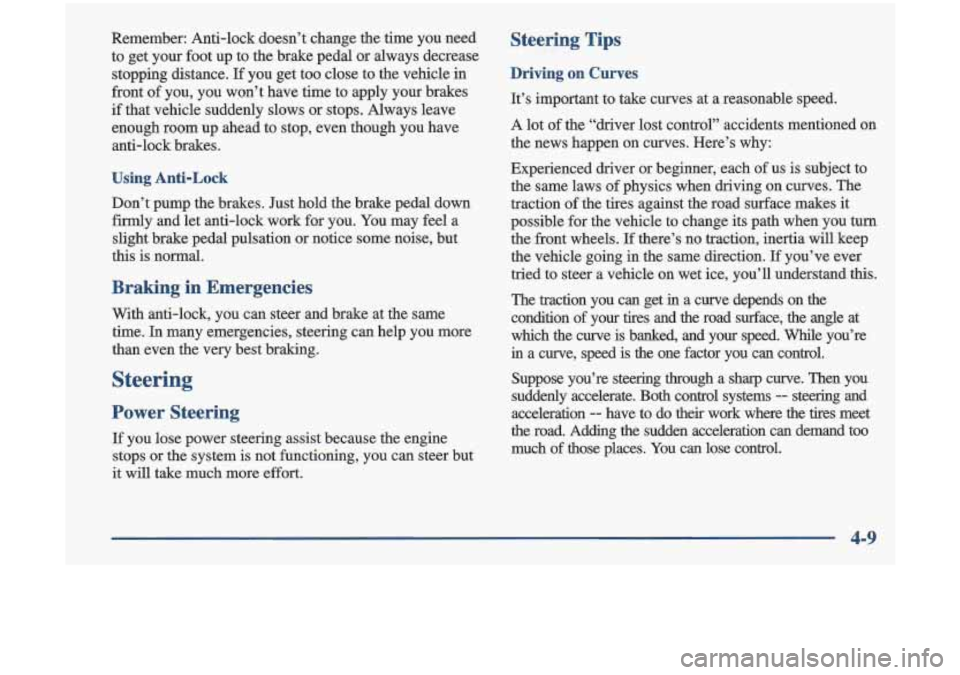
Remember: Anti-lock doesn’t change the time you neea
to get your foot up to the brake pedal or always decrease
stopping distance.
If you get too close to the vehicle in
front of you, you won’t have time to apply your brakes
if that vehicle suddenly slows or stops. Always leave
enough room up ahead to stop, even though you have
anti-lock brakes.
Using Anti-Lock
Don’t pump the brakes. Just hold the brake pedal down
firmly and let anti-lock work for you. You may feel a
slight brake pedal pulsation
or notice some noise, but
this is normal.
Braking in Emergencies
With anti-lock, you can steer and brake at the same
time. In many emergencies, steering can help you more
than even the very best braking.
Steering
Power Steering
If you lose power steering assist because the engine
stops or the system is not functioning, you can steer but
it will take much more effort.
Steering Tips
Driving on Curves
It’s important to take curves at a reasonable speed.
A lot of the “driver lost control” accidents mentioned
on
the news happen on curves. Here’s why:
Experienced driver or beginner, each of us is subject to
the same laws of physics when driving on curves. The
traction
of the tires against the road surface makes it
possible for the vehicle to change its path when you
turn
the front wheels. If there’s no traction, inertia will keep
the vehicle going in the same direction.
If you’ve ever
tried to steer a vehicle on wet ice, you’ll understand
this.
The traction you can get in a curve depends on the
condition of your tires and the road surface,
the angle at
which the curve is banked, and your speed. While you’re
in a curve, speed is the one factor you can control.
Suppose you’re steering through a sharp curve. Then you
suddenly accelerate. Both control systems
- steering and
acceleration
-- have to do their work where the tires meet
the road. Adding the sudden acceleration can demand too
much
of those places. You can lose control.
4-9
Page 179 of 348

Your vehicle can tow a trailer if it is equipped with the
proper trailer towing equipment. To identify what the
vehicle trailering capacity is for your vehicle, you
should read the information
in “Weight of the Trailer”
that appears later
in this section. But trailering is
different than just driving your vehicle by itself.
Trailering means changes in handling, durability and
fuel economy. Successful, safe trailering takes correct
equipment, and it has to be used properly.
That’s the reason for this part. In it are many
time-tested, important trailering tips and safety rules.
Many of these are important for your safety and that of
your passengers.
So please read this section carefully
before you pull a trailer.
Load-pulling components such as the engine, transaxle,
wheel assemblies and tires are forced to work harder
against the drag
of the added weight. The engine is
required to operate at relatively higher speeds and under greater loads, generating extra heat. What’s more, the
trailer adds considerably to wind resistance, increasing
the pulling requirements.
If You Do Decide To Pull A Trailer
If you do, here are some important points:
0
0
0
0
0
There are many different laws, including speed limit
restrictions, having to do with trailering. Make sure
your rig will be legal, not only where you live but
also where you’ll be driving. A good source for this
information can be state or provincial police.
Consider using a sway control. You can ask
a hitch
dealer about sway controls.
Don’t tow a trailer at all during the first
1,000 miles
(1 600 km) your new vehicle is driven. Your engine,
axle
or other parts could be damaged.
Then, during the first
500 miles (800 Ian) that you
tow a trailer, don’t drive over
50 mph (80 km/h) and
don’t make starts at full throttle.
This helps your
engine and other parts of your vehicle wear in at the
heavier loads.
Obey speed limit restrictions when towing a trailer.
Don’t drive faster than the maximum posted speed
for trailers (or no more than
55 mph (90 lun/h)) to
save wear on your vehicle’s
parts.
4-33
I
Page 194 of 348
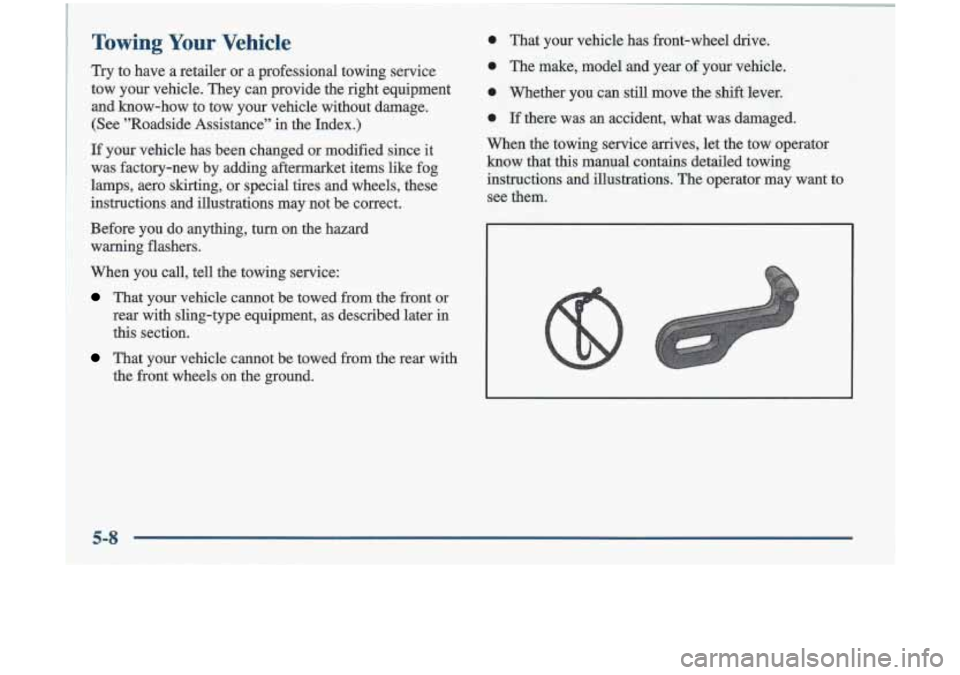
Towing Your Vehicle
Try to have a retder or a professional towing service
tow your vehicle. They can provide the right equipment
and
know-how to tow your vehicle without damage.
(See ”Roadside Assistance”
in the Index.)
If your vehicle has been changed or modified since it
was factory-new by adding aftemarket items like
fog
lamps, aero skirting, or special tires and wheels, these
instructions and illustrations may not be correct.
Before you do anything,
turn on the hazard
warning flashers.
When you call, tell the towing service:
That your vehicle cannot be towed from the front or
rear with sling-type equipment, as described later
in
this section.
That your vehicle cannot be towed from the rear with
the front wheels on the ground.
Page 208 of 348
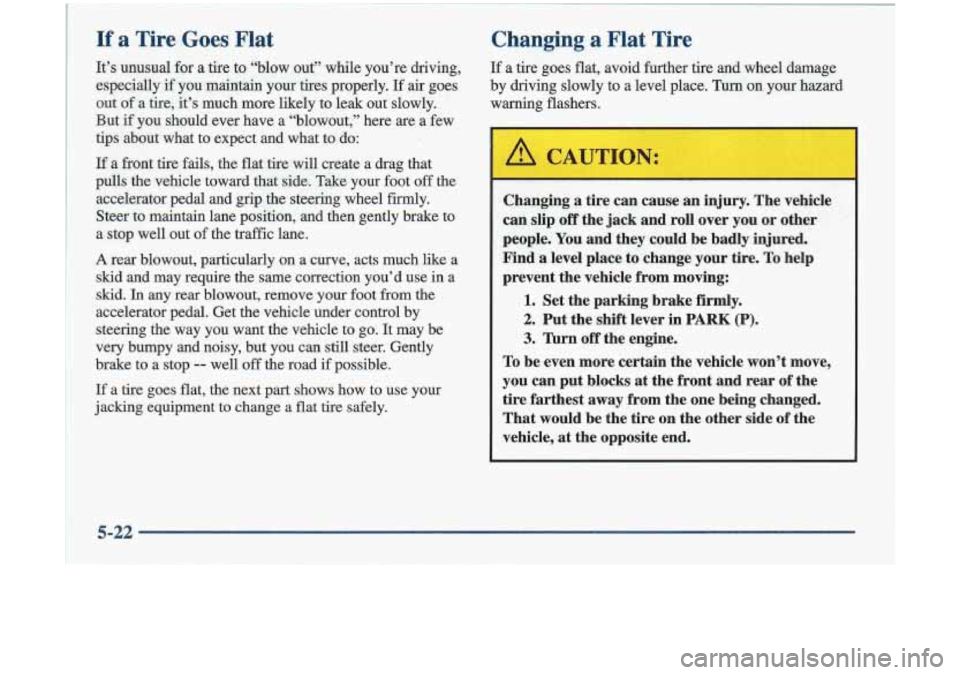
~~ ~. ~~ ~
If a Tire Goes Flat
It’s unusual
for a tire to “blow out” while you’re driving,
especially if you maintain your tires properly. If air goes
out
of a tire, it’s much more likely to leak out slowly.
But if you should ever have a “blowout,” here
are a few
tips about what to expect and what to do:
If a front tire fails, the flat tire will create a drag that\
pulls the vehicle toward that side. Take your foot off the
accelerator pedal and grip the steering wheel firmly.
Steer to maintain lane position, and then gently brake to
a stop well out of the traffic lane.
A rear blowout, particularly on a curve, acts much like a
skid and may require the same correction you’d use in a
skid.
In any rear blowout, remove your foot from the
accelerator pedal. Get the vehicle under control by
steering the way you want the vehicle to
go. It may be
very bumpy and noisy, but you can still steer. Gently
brake to a stop
-- well off the road if possible.
If a tire goes flat, the next part shows how to use your
jacking equipment to change a flat tire safely.
Changing a Flat Tire
If a tire goes flat, avoid further tire and wheel damage
by driving slowly to
a level place. Turn on your hazard
warning flashers.
:, , ,::*,,
Changing a tire can cause an injury. The vehicle
can slip off the jack and roll over you or other
people. You and they could be badly injured.
Find
a level place to change your tire. To help
prevent the vehicle from moving:
1. Set the parking brake firmly.
2. Put the shift lever in PARK (P).
3. ’krn off the .engine.
To be even more certain the vehicle won’t move,
you can put blocks
at the front and rear of the
tire farthest away from the one being changed.
That would be the’ tire on the other side of the
vehicle, at the opposite end.
5-22
Page 214 of 348
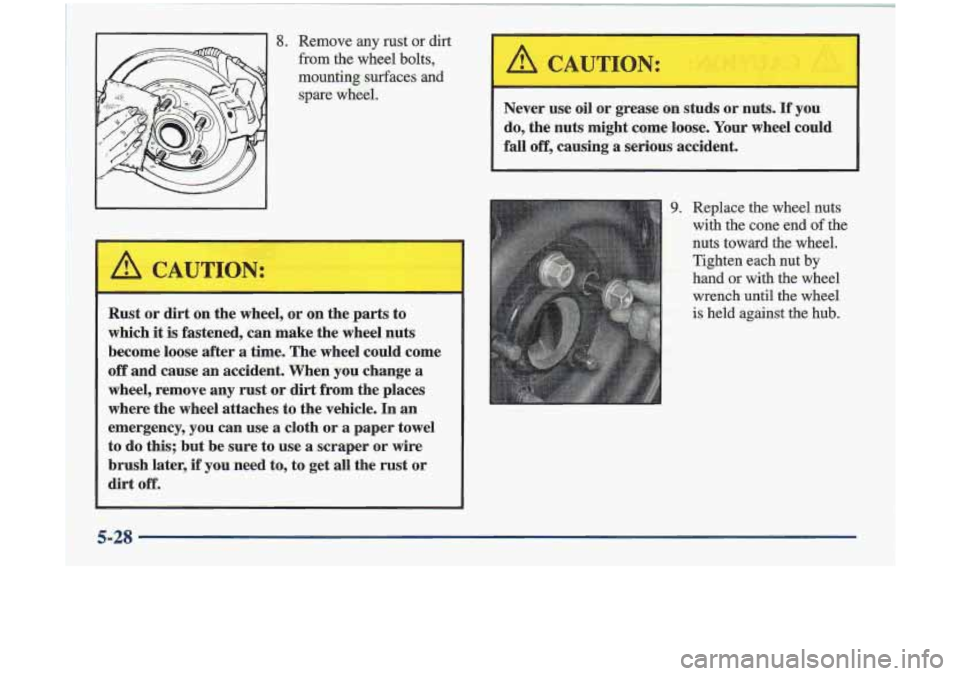
Rust or dirt on the wheel, or on the parts to
which
it is fastened, can make the wheel nuts
become loose after a time. The wheel could come
off and cause an accident. When you change
a
wheel, remove any rust or dirt from the places
where the wheel attaches to the vehicle.
In an
emergency, you can use
a cloth or a paper towel
to do this; but be sure to use
a scraper or wire
brush later,
if you need to, to get all the rust or
dirt
off.
Never use oil or grease on studs or nuts. If you
do, the nuts might come loose. Your wheel could
fall off, causing a serious accident.
9. Replace the wheel nuts
with the cone end
of the
nuts toward the wheel.
Tighten each nut by
hand
or with the wheel
wrench until the wheel is held against the hub.
Page 257 of 348
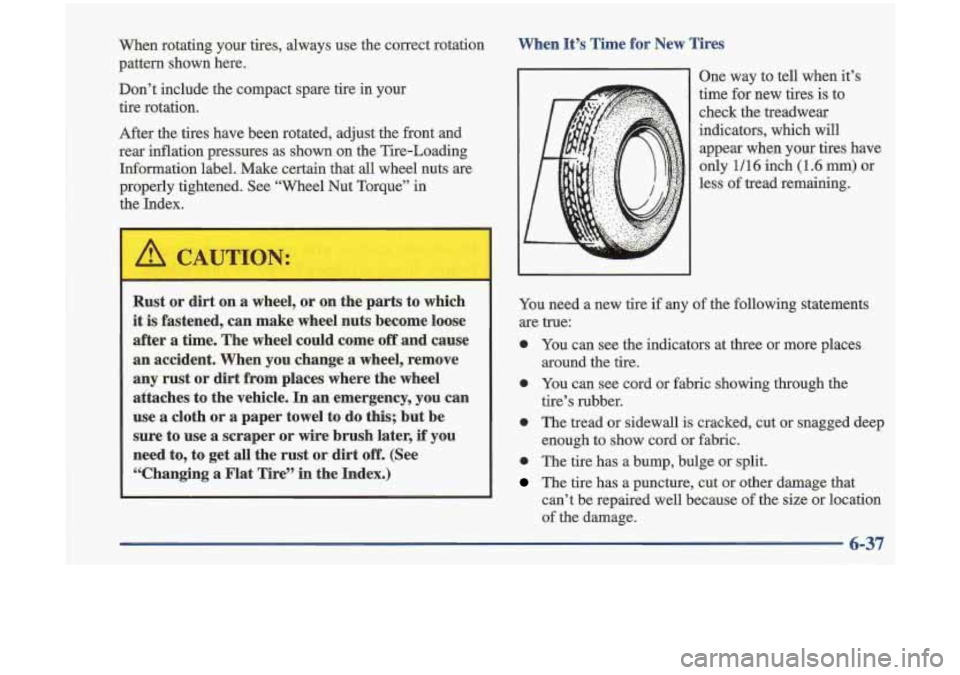
When rotating your tires, always use the correct rotation
pattern shown here.
Don’t include the compact spare tire in your
tire rotation.
After the tires have been rotated, adjust the front and
rear inflation pressures as shown on the Tire-Loading
Information label. Make certain that
all wheel nuts are
properly tightened. See “Wheel Nut Torque” in
the Index.
[ ,A c,
Rust or dirt on a wheel, or on the parts to which
it is fastened, can make wheel nuts become loose
after
a time. The wheel could come off and cause
an accident. When you change a wheel, remove
any rust or dirt from places where the wheel
attaches to the vehicle.
In an emergency, you can
use a cloth or
a paper towel to do this; but be
sure to use
a scraper or wire brush later, if you
need to, to get all the
rust or dirt off. (See
“Changing a Flat Tire” in the Index.) When It’s Time
for New Tires
One way to tell when it’s
time for new tires is to
check the treadwear
indicators, which will appear when your tires have
only 1/16 inch (1 -6 mm) or
less of tread remaining.
You need a new tire
if any of the following statements
are true:
0 You can see the indicators at three or more places
around the tire.
0 You can see cord or fabric showing through the
tire’s rubber.
0 The tread or sidewall is cracked, cut or snagged deep
enough to show cord or fabric.
0 The tire has a bump, bulge or split.
The tire has a puncture, cut or other damage that
can’t be repaired well because
of the size or location
of the damage.
6-37
I
Page 335 of 348
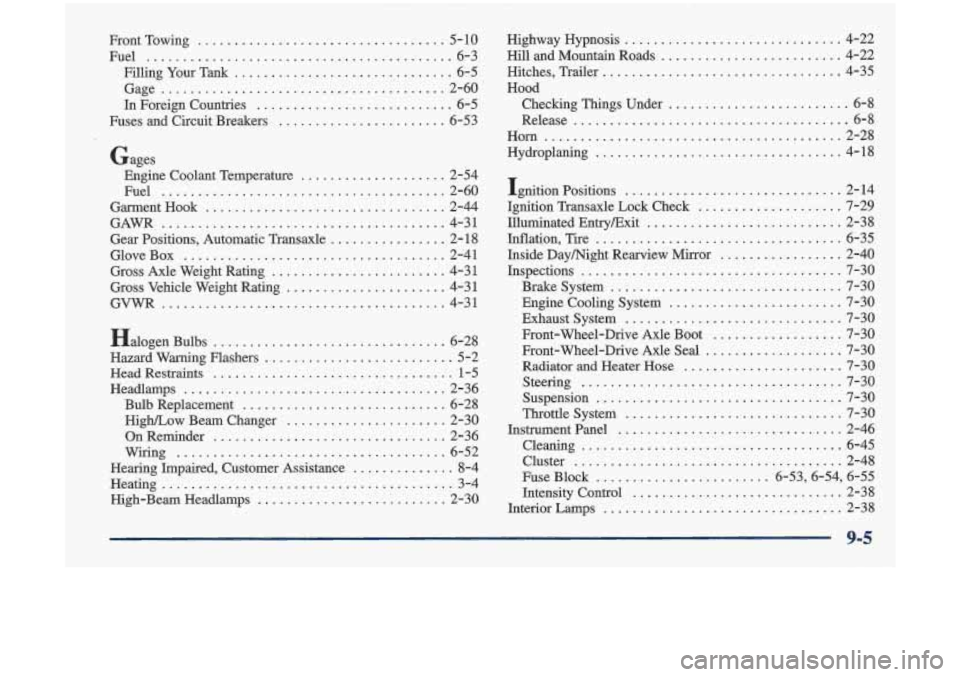
rrontTowing .................................. 5-10
Fuel
.......................................... 6-3
Filling
Your Tank .............................. 6-5
Gage
....................................... 2-60
In Foreign Countries
........................... 6-5
Fuses and Circuit Breakers
....................... 6-53
Gages Engine Coolant Temperature
.................... 2-54
Fuel
....................................... 2-60
GarmentHook
................................. 2-44
GAWR ....................................... 4-31
Gear Positions, Automatic Transaxle
................ 2- 18
GloveBox
.................................... 2-41
Gross Axle Weight Rating
........................ 4-31
Gross Vehicle Weight Rating ...................... 4-31
GVWR ....................................... 4-31
Halogen Bulbs
................................ 6-28
Hazard Warning Flashers
.......................... 5-2
Head Restraints
................................. 1-5
Bulb Replacement
............................ 6-28
High/Low Beamchanger ...................... 2-30
OnReminder
................................ 2-36
Wiring
..................................... 6-52
Hearing Impaired, Customer Assistance
.............. 8-4
Heating
........................................ 3- 4
Headlamps .................................... 2-36
High-BeamHeadlamps
.......................... 2-30 Highway Hypnosis
.............................. 4-22
HillandMountainRoads
......................... 4-22
Hitches. Trailer
................................. 4-35
Hood Checking Things Under
......................... 6-8
Release
...................................... 6-8
Horn ......................................... 2-28
Hydroplaning
.................................. 4-18
Ignition Positions
.............................. 2-14
Ignition Transaxle Lock Check
.................... 7-29
Illuminated EntryExit
........................... 2-38
Inflation, Tire
.................................. 6-35
Inside Daymight Rearview Mirror
................. 2-40
Inspections
.................................... 7-30
Brakesystem
................................ 7-30
Engine Cooling System
........................ 7-30
Exhaust System
.............................. 7-30
Front-Wheel-Drive Axle Boot
.................. 7-30
Front-Wheel-Drive Axle Seal
................... 7-30
Radiator and Heater Hose
...................... 7-30
Suspension
.................................. 7-30
Throttle System
.............................. 7-30
Instrumentpanel
............................... 2-46
Cleaning
.................................... 6-45
Cluster
..................................... 2-48
Fuse Block
........................ 6-53,6-54,6-5. 5
Intensity Control
............................. 2-38
Interior Lamps
................................. 2-38
Steering
.................................... 7-30
9-5
Page 341 of 348
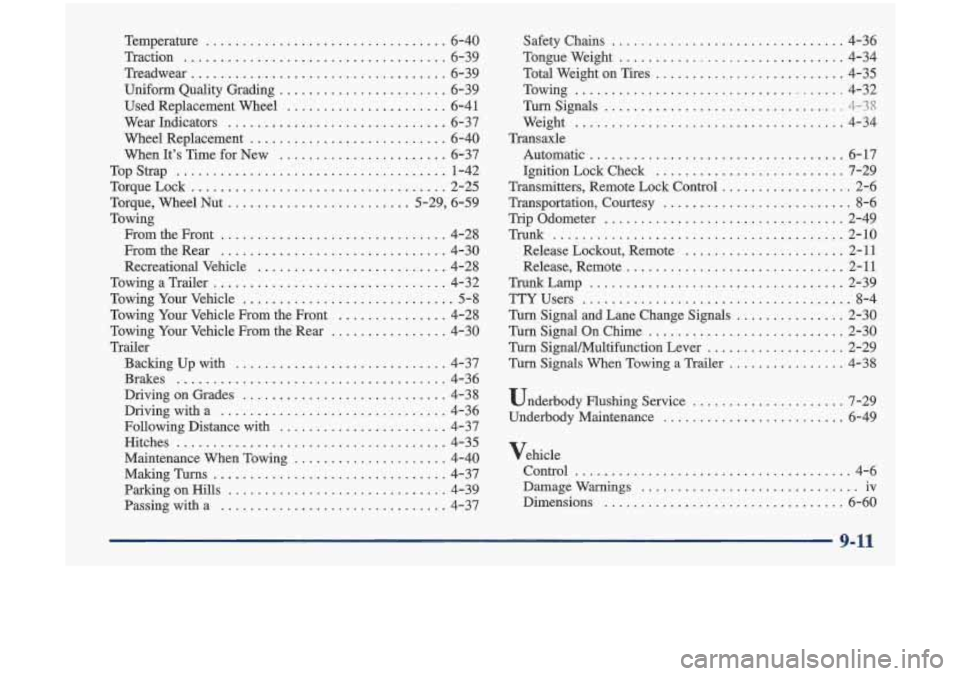
Temperature ................................. 6-40
Traction
.................................... 6-39
Treadwear
................................... 6-39
Uniform Quality Grading
....................... 6-39
Used Replacement Wheel
...................... 6-41
Wear Indicators
.............................. 6-37
Wheel Replacement
........................... 6-40
When It’s Time
for New ....................... 6-37
TopStrap
..................................... 1-42
Torque. Wheel Nut
......................... 5.29. 6.59
Towing FromtheFront
............................... 4-28
From the Rear
............................... 4-30
Recreational Vehicle
.......................... 4-28
TowingaTrailer
................................ 4-32
Towing Your Vehicle
............................. 5-8
Towing Your Vehicle From the Front
............... 4-28
Towing Your Vehicle From the Rear
................ 4-30
Trailer
Backing Up with
............................. 4-37
Brakes
..................................... 4-36
DrivingonGrades
............................ 4-38
Drivingwitha
............................... 4-36
Following Distance with
....................... 4-37
Hitches
..................................... 4-35
Maintenance When Towing
..................... 4-40
Making TWS
................................ 4-37
ParkingonHills
.............................. 4-39
Passingwitha
............................... 4-37
TorqueLock
................................... 2-25
Safety Chains
................................ 4-36
Tongueweight
............................... 4-34
Total Weight on Tires
.......................... 4-35
Towing
..................................... 4-32
Turn Signals
................................. 4-38
Weight ..................................... 4-34
Automatic
................................... 6-17
Ignition Lock Check
.......................... 7-29
Transmitters. Remote Lock Control
.................. 2-6
Transportation. Courtesy
.......................... 8-6
Trip Odometer
................................. 2-49
Trunk
........................................ 2-10
Release Lockout. Remote
...................... 2-11
Release. Remote
.............................. 2-11
TrUnkLamp
................................... 2-39
TTYUsers
..................................... 8-4
Turn Signal and Lane Change Signals ............... 2-30
Turn Signal On Chime
........................... 2-30
Turn Signal/Multifunction Lever
................... 2-29
Turn Signals When Towing a Trailer
................ 4-38
Underbody Flushing Service
..................... 7-29
Transaxle
Underbody Maintenance
......................... 6-49
Vehicle Control
...................................... 4-6
Damage Warnings
.............................. iv
Dimensions
................................. 6-60
9-11